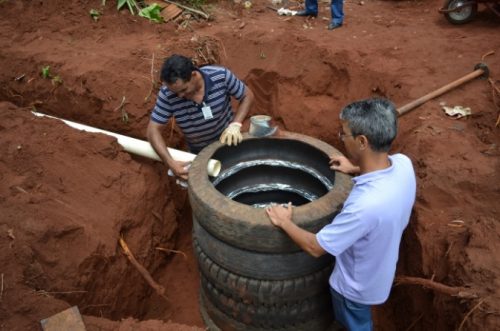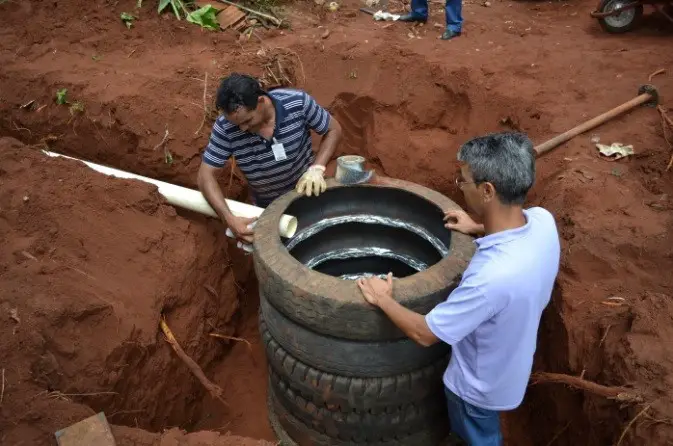The overview of a sustainable septic tank made with recycled tires is an off the grid option for homesteaders.
In order to help replicate the idea, a manual to has also been created based on this knowledge.

Several cities in Brazil have been faced with numerous sanitation problems, one of which is the problem of disposing solid waste. Recently, an interesting alternative to creating septic tanks with reuse materials was developed by Uberlândia Prefecture.
This new invention has not only proven to be efficient at regulating solid waste disposal, it has also helped in controlling other common sanitation problems.
Truck tires were used to create the septic tank in the mining town. The body responsible for the production and installation of these sustainable tanks is the Municipal Department of Water and Sewerage (DMAE).
Only eight truck tires are required to make these sustainable tanks for each household which is directly connected to the toilet. The tank is divided into two modules – while one is principally used for decomposing waste, the other serves as a container for holding fluids. Bacteria react on the decomposing waste which helps to remove about 95% of the organic matter.
Now, at little or no cost at all, homes can now gain access to sustainable septic tanks designed for proper waste management. According to DMAE, more and more farmers and people living in the farms, mining sites and other remote areas are becoming interested in this cost-effective sewage system.
The septic tank developed by the City of Uberlândia is an interesting alternative to reuse materials that would be discarded, while at the same time solving part of the problem of basic sanitation, common in several Brazilian cities.
The Municipal Department of Water and Sewage (DMAE) is the body responsible for the creation of the system and for the manufacture of sustainable cesspools delivered in the city of Minas Gerais. But, in order not to limit knowledge, they have created a manual that gives step by step for the idea to be replicated anywhere.
The basis for manufacturing this pit is truck tires, often obtained at no cost. According to the DMAE, this fossa model has attracted many rural producers and people living on sites and farms in remote areas that are not served by sewage collection networks.
Each pit uses eight tires, divided into two modules. The connection is made directly to the toilet. In the first module occurs the decomposition of the tailings through bacteria. The organic matter is deposited in the container world, while the generated liquid goes to the second module, where the bacteria continue to act, removing up to 95% of the contaminating organic matter.
What is it? A drain field is a wastewater disposal system consisting of a series of perforated pipes laid along the bottom of trenches, connected to the outlet from a septic tank. The pipes are normally surrounded by gravel, to increase the percolation area and reduce the possibility that the perforations will become blocked, the The basic function of a drain field is to deal with the septic tank effluent by allowing it to percolate into the ground, which serves as an effective treatment mechanism. A leach pit could be used for the same purpose.
Sewerage
We are using a conventional flush toilet, flushed with the gray water once the plants have used it. The waste and water flush down into our own onsite sewerage system. It goes into our ‘septic system’ underground which is a deep cell lined with large car tires and gravel and tiny microorganisms which digest and feed off the waste. The water then flows outside through a pipe away from the house to our exterior black water cell which will be planted with citrus trees is quoted from the website http://permaculturenews.org/

Here is the translation of the above photo from “PrefUberlandia” from Portuguese into English.
WHAT IS THE SUSTAINABLE SEPTIC TANK?
It is the septic tank developed by Uberlândia’s Water Supply and Drainage Company, made with used truck tires that have been discarded. It is an economic and efficient way to solve two major problems: the lack of sanitation in rural areas and the accumulation of used tires that are often improperly disposed of outdoors.
HOW DOES THE SEPTIC TANK WORK?
It consists of two modules, each one made with four tires. The connection is made directly with the toilet. Within module 1, the sewage is decomposed by the action of bacteria. Organic matter is then deposited on the bottom, and the liquid generated proceeds to the second module. There, bacteria continue to act, removing approximately 95% of the contaminant organic matter.
HOW TO MAKE A SEPTIC TANK AT HOME
Materials needed to build a septic tank with capacity to serve a household with up to four people:
MATERIAL AMOUNT
Truck tires 8
5/8 screws 24
Iron bar 12 metres (4.8mm) 1
Iron bar 12 metros (6mm) 1
5/8 wide rim washers 48
Cement 1 and a half bag
Medium sand 24 cans
Gravel #5 6 cans
Aluminium foil tape 20 metres
PVC 90° quarter bend 100mm 4
PVC tube bar 100mm 3
BUILDING YOUR SUSTAINABLE SEPTIC TANK
1. Choose the place to install the septic tank – it can neither be too close to the house, because of the stench, nor too far away from it, to avoid long pipes and deep trenches. The recommended distance is around 6 meters. The septic tank must be installed next to the toilet to avoid bends in pipes, and at a lower level of terrain, away from water wells. The minimum distance from a source of water is 50 metres, so that there won’t be contamination of the water in the event of a leak.
2. Put the modules together. First, puncture the tires on the spots shown on the picture. Then, apply the aluminium foil tape between the tires before screwing them together. That foil blanket must be the same size as the tire circumference, and its purpose is to seal the modules, in order to prevent the sewage to spill.
3. The next step is to open the trench that will receive the modules. The trench should measure approximately 1.4m depth, 1.5m width and 3m length.
4. You can make yourself the 2 rings and 2 reinforced concrete caps to install the pipe and close the septic tank. Use iron, sand, cement and gravel. Prepare the concrete mass and place it in the shape of the diameter of the tire circumference, with 14cm of height. The shape of the ring must have a way in and a way out for a 100mm pipe. The lids must have the same circumference of the tire and be 5cm tick. One of them will be compact and the other will have a central hole of 0.5 inch.
5. Place the modules in the trench. The bottom of each module must be compressed to receive a layer of concrete with at least 5cm. Then, install the rings.
6. Install the pipes. In the first module, install the access for the PVC pipe and 90° quarter bend with 90cm of depth. Install the exit pipe at the height of the first module and insert a 90° elbow on its end. That is 1.5m of tube, 20cm of which into the second module. On the end of it, install another 90° elbow and a tube with 90cm depth. The tube that will serve as a drain will be installed at the height of the second module. Next, apply aluminium foil tape between the tire and the rings.
7. Prepare a trench to bury the drain. The depth should be compatible with the slope of the terrain. Apply a layer of sand and gravel on the base. Before installing the 6m tube, make several holes 2m up from its edge, so that the liquid generated at the end of the process can infiltrate the soil. Plant banana treed around the drain, as they will absorb the drained liquid. This liquid will provide nutrients for the plants and will not contaminate the soil. But be careful – it shouldn’t be directed to the vegetable garden.
8. Install the lid with a central hole in the first module and the compact lid in the second module. You must also install a pipe into the hole on the lid of the first module, with diameter of 0.5 inch and height of 1.5m, in order to release the gases that will be generated in the process. It must point upwards.
9. You have now reached the final stage of the construction and installation of the septic tank. Connect the first module to the toilet, using a 100mm tube. The length of the tube must observe the distance between the toilet and the first module.
Click here to read about a overview of sustainable septic tank made with recycled tires :
https://translate.google.com/translate?sl=auto&tl=en&js=y&prev=_t&hl=en&ie=UTF-8&u=http%3A%2F%2Fciclovivo.com.br%2Fnoticia%2Fmanual-ensina-a-fazer-fossa-septica-sustentavel-com-pneus-reaproveitados%2F&edit-text=&act=url


